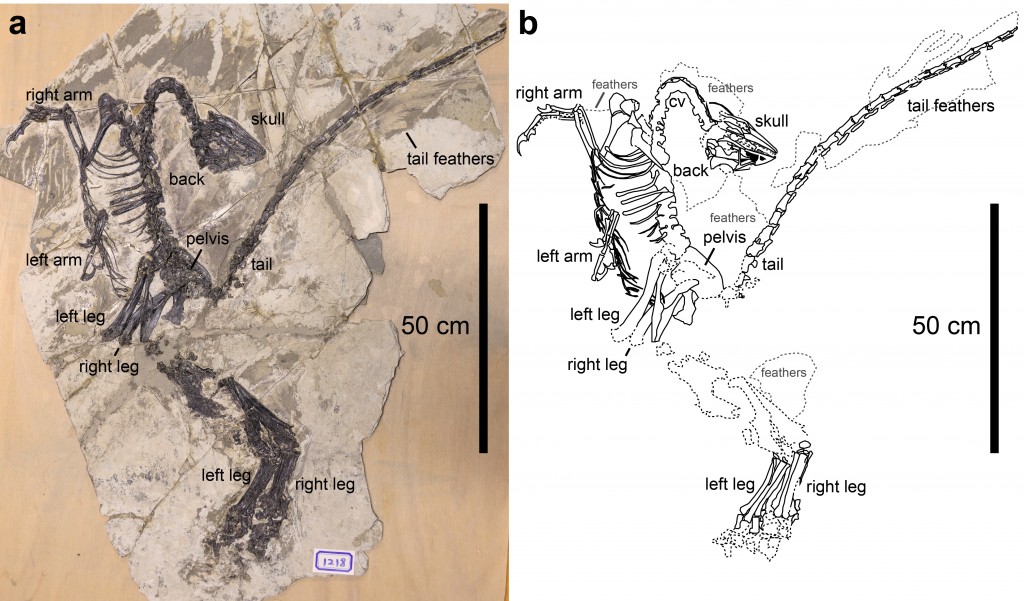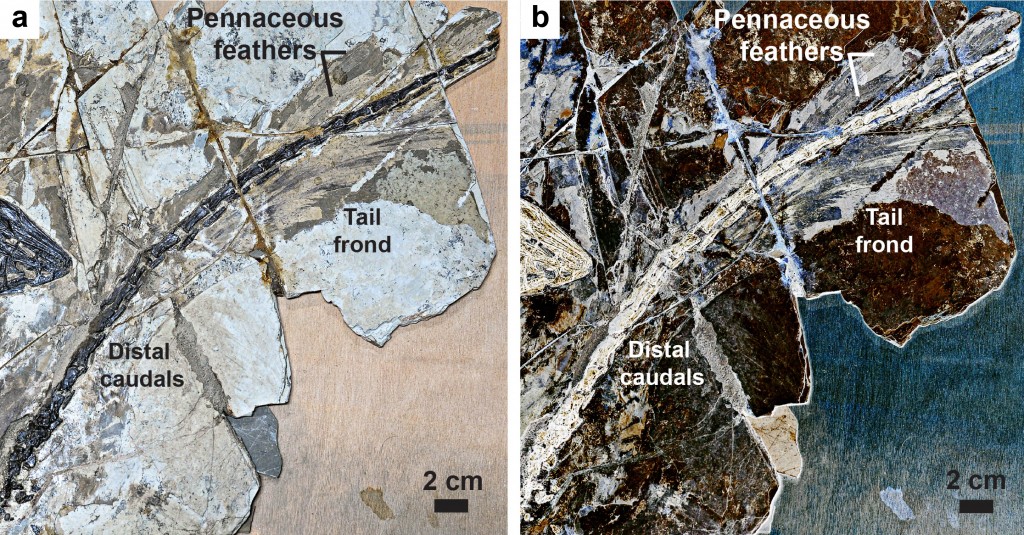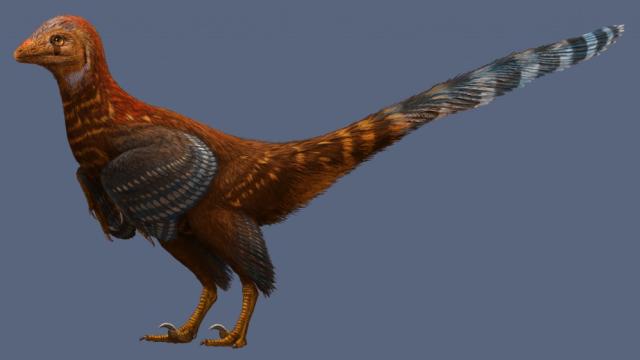Meet Jianianhualong tengi, a distinctly chicken-like dinosaur that lived 125 million years ago, during the Cretaceous period. This newly discovered species of dinosaur now represents the earliest known common ancestor of birds and closely related bird-like dinos, with a feathering pattern associated with aerodynamics. Its discovery is offering new insights into the evolution of feathers and flight.
Say hello to Jianianhualong tengi. (Credit: Julius T. Csotonyi 2017 / Xu, Currie, Pittman et al. 2017)
As described in Nature Communications, this feathered dinosaur is now the earliest known troodontid, a group of bird-like dinosaurs, to feature asymmetric feathers — a key innovation associated with the evolution of flight. Troodontids, along with dromaeosaurs (popularly known as Velociraptors), are the closest known relatives to birds. The discovery of asymmetric feathers in such an ancient species indicates that the closest common ancestor of birds and bird-like dinosaurs had this feature, extending the emergence of the evolutionary trait further back in time.
A beautifully preserved fossil of a three-foot long J. tengi was recently discovered in Northeastern China in Baicai Gou, Liaoning Province. An international team of paleontologists, co-led by Michael Pittman from the University of Hong Kong, analysed the fossil using standard comparative anatomical techniques and LSF imaging, which involves shining violet laser light at the specimen. This light causes the fossil to glow, bringing additional clarity to the feather and bone anatomy.
As the researchers worked on the specimen, it became clear they were dealing with an entirely new species of troodontids, which they dubbed Jianianhualong tengi (the dinosaur is named in honour of Teng Fang Fang, who provided the fossil for scientific study).

A photograph and line drawing of the fossil. (Credit: Xu, Currie, Pittman et al. 2017)
“Troodontids are a group of bird-like dinosaurs that together with the bird-like raptors — called dromaeosaurs — share their closest common ancestor with birds,” Pittman told Gizmodo. “Troodontids are therefore crucial in understanding the origin of birds and flight. These dinosaurs were extremely bird-like — and in fact, Jianianhualong tengi would have looked like a toothed, long-tailed chicken!”
Pittman says that J. tengi represents an important transitional form in the evolution of troodontids, a creature that featured large feathers on its forelimbs, hind limbs, and tail. The feathers on its tail exhibited a leaf-like arrangement, similar to another early long-tailed bird-like creature, Archaeopteryx (this creature also had asymmetric feathers, and lived 150 million years ago, but it’s not a true ancestor of birds).
Of significance, the tail feathers were asymmetrically vaned, meaning one side was wider than the other.
“Feathers have a central axis called a rachis with vanes either side of it. An asymmetrical feather is one with vanes that have different sizes (the areas either side of the rachis are different from one another),” explained Pittman. “Symmetrical feathers have vanes of roughly the same size.”

An asymmetrical tail feather from the fossil. (Credit: Xu, Currie, Pittman et al. 2017)
Asymmetrical feathers are associated with aerodynamics and flight capability (they are also known to exist in the non-avian gliding dromaeosaurid Microraptor), but they’re also found in species that do not fly. Consequently, their appearance during feather evolution is considered a major event.
“Jianianhualong is not the oldest fossil with asymmetrical feathers,” said Pittman. “However, as the only known troodontid with this feather type, the addition of this crucial new data point reveals that the closest common ancestor of birds, troodontids and raptors had this feather type — it is this that pushes back the earliest record of this feather type.”

A photo and laser-stimulated view of the fossilized tail frond, which takes on a leaf-like arrangement. (Credit. Xu, Currie, Pittman et al. 2017)
Since asymmetric feathers are generally associated with aerodynamics, the researchers to hypothesize that they confer some kind of aerodynamic benefit in J. tengi. That said, the researchers don’t have enough data to prove that this animal could glide or fly. “A big issue is that the wing feathers are not well-preserved at present which is crucial towards assessing flight capability,” Pittman told Gizmodo. “The data we have at present is insufficient to comment on its flying ability at this time.”
Looking ahead, the researchers are hoping to find more troodontid and dromaeosaurid fossils with traces of similar feathering patterns. “These new data will help us to better understand how early asymmetrical feather evolution proceeded and whether this started with aerodynamic or non-aerodynamic beginnings,” said Pittman.
